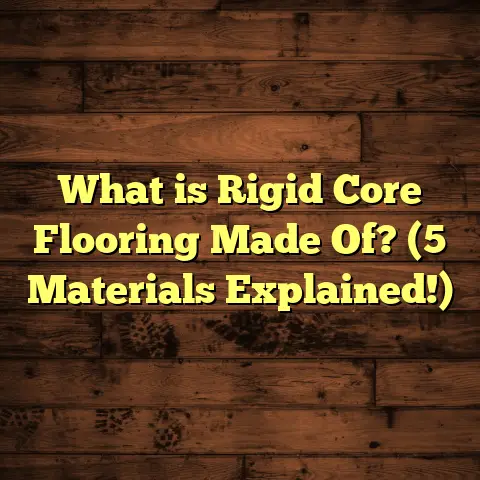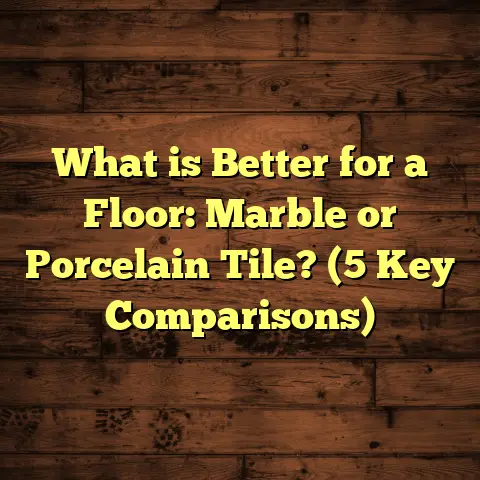What is a Finished Floor Footprint? (5 Key Facts for Builders)
What is a Finished Floor Footprint?
Adaptability is something I’ve always valued in my work as a flooring contractor. Each job site is different—dimensions aren’t always perfect rectangles, materials vary, and client preferences shift. Over time, I realized that one term kept coming up during planning meetings that many builders and homeowners didn’t fully understand: the finished floor footprint.
You might guess it’s just the floor area, but it’s more specific than that. The finished floor footprint refers to the exact area of flooring surface after installation is complete. It’s the space the final flooring material covers — not just a rough room measurement or subfloor size.
Knowing this footprint precisely can save you headaches with ordering materials, budgeting labor costs, and preventing delays. I’m going to walk you through five key facts I’ve learned over years that will help you get this right every time. Plus, I’ll share some stories and data from my own projects to make these tips practical and actionable.
Why Measuring Finished Floor Footprint Matters More Than You Think
You might ask, “Why can’t I just use room dimensions for ordering?” That’s what many builders do at first, including myself early on. But rooms aren’t always simple squares or rectangles, and there are often cutouts, closets, or built-in cabinetry that reduce the actual floor area needing coverage.
One job I worked on had what seemed like a straightforward L-shaped kitchen floor. The architect’s blueprints showed the room was about 350 square feet. I ordered materials accordingly. When we started installation, we found several built-ins and appliance bays weren’t accounted for in the rough dimensions. The finished floor footprint was closer to 310 square feet.
This 40 square foot difference meant I had over-ordered materials by around 13%. While having extra material isn’t the worst thing, it ties up cash flow and storage space. More importantly, if I had underestimated instead, it could have caused delays and rush orders that increase costs.
That experience taught me the value of measuring the finished floor footprint carefully before buying anything or scheduling installation.
1. The Finished Floor Footprint Directly Impacts Material Ordering and Waste
When you’re ordering flooring materials like hardwood planks, tiles, vinyl sheets, or laminate, knowing exactly how many square feet you need is critical. But it’s not just about ordering enough—it’s about optimizing so you don’t waste money on excess.
How Waste Factors Play Into Finished Floor Footprint
You’ve probably heard about waste factor before—how you buy extra flooring material to cover cuts, mistakes, or damaged pieces. What I want to highlight is how your finished floor footprint measurement influences this calculation.
For example:
- A simple rectangular room with hardwood flooring might need a waste factor of around 5-7%.
- A complex space with diagonal tile layouts or patterned hardwoods could require up to 15% extra.
- Rooms with many corners or cutouts naturally increase waste because installers have to cut more pieces to fit.
By accurately measuring the finished floor footprint, you can apply a waste factor that matches your layout complexity rather than guessing.
Real Data From My Projects
Over dozens of projects, here’s what I found about waste factors relative to finished floor footprints:
| Project Type | Average Waste Factor | Notes |
|---|---|---|
| Straight Hardwood | 5-7% | Minimal cuts and simple layouts |
| Patterned Hardwood | 10-15% | Herringbone or chevron increases waste |
| Basic Tile | 8-12% | Standard grid layout |
| Complex Tile Layouts | 15%+ | Diagonal, mosaic patterns increase waste |
| Vinyl & Laminate | 3-5% | Usually less waste due to flexible sizes |
In one early project installing patterned hardwood in a client’s living room (about 500 sq ft footprint), failing to account for a proper waste factor led us to run out mid-installation. We had to rush order 50 additional square feet at a premium price.
Lesson learned: Know your footprint first, then match your waste factor accordingly.
2. Distinguishing Between Subfloor and Finished Floor Footprint Prevents Costly Mistakes
This one caught me off guard when I first started—subfloor area and finished floor footprint are often confused but are NOT the same thing.
What’s the Difference?
The subfloor is the base layer under your final flooring—usually plywood, OSB, or concrete slab—that supports everything above it. The finished floor footprint is specifically the surface of your final flooring material after installation.
Sometimes subfloors are larger than the finished floor area because they extend under walls or cabinets. For example, concrete slabs often go beyond wall lines for structural reasons but won’t be exposed as finished floors.
Why Does This Matter?
If you use subfloor measurements for ordering materials or estimating labor, you’ll likely overestimate both. Laborers charge based on finished floor area they install, so billing based on subfloor could lead to disputes or inflated costs.
In one commercial project early in my career, we measured the entire concrete slab (including an under-cabinet area) as our flooring area. We ordered enough carpet tiles for that whole slab but only installed in accessible spaces. The leftover tiles were wasted inventory—not accounted for in budgeting.
My Tip
Always measure or verify with installers the exact finished floor footprint after any cabinetry or built-in elements are installed but before flooring starts. This gives you a realistic target for ordering and estimating labor hours.
3. Different Flooring Materials Affect Your Finished Floor Footprint Calculations
Not all flooring materials behave alike when installed. Some require expansion gaps; others can be placed edge-to-edge. This subtle difference affects how much usable area you actually cover and what size footprint you should plan for.
Expansion Gaps Shrink Your Usable Footprint
Materials like solid hardwood or engineered hardwood usually require a gap (typically 1/4 inch to 3/8 inch) between the flooring edge and walls to allow for natural expansion and contraction.
These gaps don’t get covered by flooring but are hidden under baseboards or quarter rounds. Still, when calculating your finished floor footprint for ordering purposes, you have to subtract these gaps from total room dimensions.
Vinyl Planks & Laminate Are More Flexible
Vinyl plank and laminate flooring can often be installed closer to walls with smaller gaps—sometimes as little as an eighth of an inch—meaning your finished floor footprint is closer to the full room dimension.
This difference might seem small but can add up over large areas. For example, in a 1,000 sq ft room:
- With a 3/8 inch gap around a perimeter of 130 linear feet (roughly a 35×30 ft room), you lose about 40 sq ft of usable floor.
- With a smaller gap (1/8 inch), it’s closer to a 15 sq ft loss.
My Experience
On one project installing solid hardwood in an open-plan living/dining area (~1,200 sq ft), accounting for expansion gaps reduced my finished floor footprint by roughly 45 sq ft compared to subfloor size.
Failing to subtract this would’ve led me to overorder and inflate my budget unnecessarily.
4. Waste Factor Isn’t Just Extra Material — It’s About Efficiency and Planning
I want to change how you think about waste factor when planning your finished floor footprint. It’s not just “buy extra” but an efficiency tool that helps avoid costly delays or poor installations.
How Waste Can Cost You More Than Materials
Think about this: running out of flooring mid-project means stopping work while waiting for new materials. This downtime costs labor hours and may incur rush shipping fees.
Additionally, some materials are prone to damage in transit or on-site handling. Having a proper waste buffer ensures you don’t have to scramble last minute.
Case Study: Tile Installation Gone Wrong
I once managed a bathroom remodel with intricate porcelain tile patterns including borders and mosaics. Initially, my calculations allowed for just 8% waste over the finished floor footprint of 120 sq ft.
Halfway through installation, several tiles cracked during cutting due to their delicate nature. We also had multiple pattern repeats requiring exact tile counts.
In reality, our waste factor needed to be closer to 18%. This miscalculation delayed completion by two days and cost $250 extra in expedited tile orders plus labor overtime.
Smart Planning Means Adjusting Waste Factor Based on Layout & Material
Here’s what I do now:
- Simple hardwood or vinyl floors get minimal waste buffer (5-7%)
- Complex patterns or diagonal layouts get higher buffer (12-15%)
- Always factor in job site conditions like narrow spaces or angled walls which increase cuts
5. Precise Finished Floor Footprint Measurement Can Save Thousands in Project Costs
Let me share a story from a recent kitchen remodel where understanding the finished floor footprint saved my client significant money.
The kitchen was L-shaped with multiple custom cabinetry pieces creating pockets where flooring wasn’t needed. Initial rough measurements showed about 450 sq ft total space.
By carefully measuring the finished floor footprint—excluding cabinetry bases and appliance bays—we landed on an accurate number: 390 sq ft.
Since hardwood flooring costs ranged from $7-$12 per sq ft including materials and installation, this saved about $1,260 – $2,340 in material and labor costs by avoiding overestimation.
If we’d ordered materials based on rough room dimensions without subtracting non-floor areas, those savings would have been lost.
Practical Tips I Use Every Day When Measuring Finished Floor Footprints
Here’s how I approach getting accurate measurements and maximizing value for each project:
Use Laser Distance Tools Whenever Possible
Tape measures work fine for small rooms but laser distance meters give far more accuracy especially in irregular spaces. I recommend models like Bosch GLM series for reliability and ease of use.
Sketch Out Your Space On Paper or Digitally
I start by drawing the room outline including closets, built-ins, doorways etc. This helps visualize where cuts will occur and estimate waste better.
There are apps like RoomScan Pro or even FloorTally’s platform that allow you to input dimensions and get instant material estimates based on your finished floor footprint plus waste factors.
Confirm Material Installation Requirements Upfront
Ask your supplier or installer about expansion gaps needed for your chosen flooring type so you can adjust your footprint accordingly.
Add Waste Factor Based on Layout Complexity
Don’t default to generic numbers—think about how many cuts you’ll need and if pattern matching is involved.
Recheck Measurements Before Ordering
Mistakes happen; double-checking can save costly errors later.
Using Technology To Streamline Finished Floor Footprint Calculation
Technology has made measuring and budgeting much easier compared to when I started over a decade ago.
FloorTally – A Game-Changer For Flooring Contractors
I’ve been using FloorTally frequently because it lets me plug in local labor rates, material prices, and customize waste factors based on my exact finished floor footprint dimensions.
This tool consolidates everything into one platform—no more juggling spreadsheets or estimating by hand.
It also visualizes total project costs clearly so clients understand where their money goes.
Laser Distance Meters With Bluetooth Connectivity
Many now sync directly with smartphones allowing instant transfer of measurements into apps like FloorTally or CAD software.
CAD/BIM Software For Larger Commercial Jobs
For big projects involving multiple rooms and complex layouts, I partner with architects who provide digital models showing exact finished floor footprints before materials are ordered.
This level of precision reduces surprises on-site dramatically.
Common Mistakes Builders Make With Finished Floor Footprints (And How To Avoid Them)
I want to share pitfalls I see repeatedly so you don’t fall into the same traps:
Mistake #1: Using Rough Room Dimensions As Flooring Area
This leads to overordering or underordering materials which either wastes money or causes delays.
Fix: Measure actual floor surface carefully excluding cabinetry walls or non-floor areas.
Mistake #2: Ignoring Expansion Gap Requirements For Hardwood Flooring
Not subtracting expansion gaps inflates your footprint estimate causing overspending.
Fix: Know manufacturer guidelines for gap size beforehand and adjust measurements accordingly.
Mistake #3: Setting Waste Factor Too Low For Complex Patterns
Cutting intricate tile designs requires more waste than simple layouts—assuming otherwise causes shortages mid-installation.
Fix: Increase waste factor based on pattern complexity and number of cuts needed.
Mistake #4: Confusing Subfloor Area With Finished Floor Area
Subfloor may extend beyond walls or cabinetry; including it inflates material estimates unnecessarily.
Fix: Measure after cabinets/appliances installed but before flooring starts for accurate finished footprint size.
Mistake #5: Not Rechecking Measurements Before Ordering Materials
Even small measurement errors multiply over large areas leading to costly mistakes.
Fix: Always double-check your numbers personally or using digital tools before placing orders.
How Finished Floor Footprint Affects Project Budgeting Beyond Materials
Beyond ordering materials efficiently, knowing your exact finished floor footprint helps with:
- Labor Cost Estimation: Installers charge per square foot of installed flooring surface.
- Scheduling Labor Hours: More precise projections prevent underestimating work time.
- Waste Disposal Planning: Helps estimate leftover scrap volume needing disposal.
- Equipment Rental Needs: Larger footprints might require additional tools or crew.
- Client Communication: Clear numbers build trust by showing transparency in quotes.
In one project managing multiple flooring types across rooms totaling nearly 3,000 sq ft finished floor footprints, detailed breakdowns helped me negotiate labor contracts confidently saving around $5k overall due to accurate scope definition.
When Should You Measure Your Finished Floor Footprint?
Timing matters too. Here’s my recommended approach:
- After framing/subfloor installation but before cabinetry/appliance installation: Gives baseline measurement.
- After cabinetry/appliance install but before flooring: Best time for final measurement of finished floor footprint.
- Before ordering materials: Final check.
If changes happen later (like moving walls or cabinets), remeasure immediately before ordering adjustments in materials or labor plans.
Real-Life Case Study: Finished Floor Footprint Precision Saves Time & Money
I want to tell you about a renovation job in an old townhouse where we faced tricky corners and small closets affecting layout drastically.
Initial rough measurements showed about 900 sq ft total room area across three floors. But after carefully measuring each room’s finished floor footprint—including all cutouts—we found only about 780 sq ft needed actual flooring material (rest covered by cabinetry or stairs).
Order was placed based on this precise number with appropriate waste factors per room type:
| Room Type | Footprint (sq ft) | Waste Factor | Total Material Ordered (sq ft) |
|---|---|---|---|
| Living Room | 300 | 7% | 321 |
| Kitchen | 180 | 10% | 198 |
| Bedrooms (2) | 300 | 5% | 315 |
We avoided over-ordering by nearly 120 sq ft compared to rough estimates saving around $1,000 just on material costs plus $600 in labor savings due to efficient workflow without material shortages or delays.
How To Communicate Finished Floor Footprint Info To Clients Clearly
Clients sometimes get confused by technical terms like “footprint.” Here’s how I explain it simply:
“Think of your finished floor footprint as the exact amount of floor surface we need to cover after everything else (like cabinets) is in place. Measuring this carefully helps us order just the right amount of material — no more no less — so we save money and avoid delays.”
Visual aids like sketches highlighting areas requiring flooring versus those excluded help clients understand better too.
Advanced Tips For Complex Projects Involving Multiple Flooring Types
Projects with varying flooring types across rooms require separate footprint calculations per material since costs and installation methods vary widely.
For example:
- Hardwood in living/dining areas.
- Tile in kitchen & bathrooms.
- Carpet in bedrooms/hallways.
Each area must be measured precisely with its unique finished floor footprint considering layout complexities and waste factors tailored per material type.
I suggest creating a spreadsheet summarizing:
| Room | Flooring Type | Finished Floor Footprint (sq ft) | Waste Factor (%) | Total Material Needed (sq ft) |
|---|---|---|---|---|
| Living Room | Engineered Wood | 400 | 7 | 428 |
| Kitchen | Porcelain Tile | 150 | 12 | 168 |
| Bedroom | Carpet | 200 | 5 | 210 |
This clarity helps clients visualize costs transparently while preventing confusion during installation billing phases.
Wrapping Up My Insights On Finished Floor Footprints
To sum things silently—not literally—remember that understanding your finished floor footprint deeply improves every stage of your flooring project from budgeting through completion:
- Avoid costly material waste by measuring exactly what needs covering.
- Account for special installation requirements like expansion gaps.
- Use tailored waste factors that reflect your layout complexity.
- Leverage modern tools like laser meters and FloorTally for accuracy.
- Communicate clearly with clients using simple terms and visuals.
- Always double-check measurements before ordering anything.
By adopting these practices I transformed how I manage projects—from stressful guesswork to smooth operations saving time and money consistently across dozens of jobs annually.
Got specific questions about measuring footprints for your next project? Want recommendations on tools? Just ask—I’m happy to share what works best from my years in the field!





